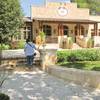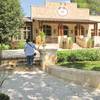

It must have been a strange – and possibly unsettling – sight for pre-Civil War Texans to encounter camels tromping through the Hill Country and points westward.
Historical accounts say the creatures from the Middle East did indeed cause havoc, especially among horses and mules that didn’t like the way the newcomers looked or smelled. The camels came to Texas as part of an experiment, the brainchild of U. S. Secretary of War Jefferson Davis, who ultimately became president of the Confederacy. Davis theorized that camels could outwork and outlast other beasts of burden in resupplying military outposts on the western frontier.
In 1854, Davis was successful in securing $30,000 from Congress to test his idea, and Maj. Henry Wayne drew the assignment of procuring camels from Egypt, shipping them across the Atlantic and marching them from Indianola on the Texas coast to Victoria, then to San Antonio and finally Camp Verde between Kerrville and Bandera.
On Aug. 26 and 27, 1856, 33 camels arrived at their new home, a cavalry installation that was “one of a chain of military posts established by the United States in western Texas after the annexation of Texas, in 1848, for the protection of settlers against hostile Indians,” according to Army records. It‘s conceivable that one of the officers assigned to the area at the time – Lt. Col. Robert E. Lee, whose specialty was engineering – laid out the camp. Other officers with connections to Camp Verde who like Lee went on to serve as Confederate generals were Albert Sidney Johnston and John Bell Hood, namesake of Fort Hood near Killeen.
So why did Camp Verde earn the distinction of becoming the “Camel Capital of Texas?” A lot had to do with its close proximity to Bandera Pass, a natural gateway through the rocky hills that had seen the comings and goings of prehistoric peoples, Native Americans, Spanish explorers, Mexican settlers, Texas Rangers and American cavalry, to name a few.
“Situated three miles from Bandera Pass and…at a distance of 60 miles from San Antonio, and in direct communication with all the frontier posts, I can conceive of no more suitable point for demonstrating everything we desire to know to the camel’s adaptation to our climate, to the military service, and to commerce….,” wrote Major Wayne in a report to Davis. In addition to its strategic location, Camp Verde on the banks of Verde Creek offered the camels ample water and grazing.
After the Civil War broke out in 1860, the camp passed into the hands of the Confederacy, and in 1865, the U. S. government again assumed control. All in all, the camels hauled more over longer distances than mules and horses, but lack of federal funding after the war and the rise of railroad transportation doomed the camel experiment. On Nov. 30, 1869, Camp Verde was deactivated, and a fire in March 1910 destroyed buildings at the site. Today, a historical marker on Camp Verde Road a mile west of State Highway 173 summarizes the place’s relatively brief but colorful story.
Yet the history of the Camel Capital lives on, thanks in large measure to the Camp Verde General Store and Restaurant, an oasis facing Verde Creek near the intersection of Ranch Road 480 and Highway 173. Camel imagery in the form of sculptures, paintings and even stained-glass windows permeates the two-story, limestone mercantile founded in 1857 as the Williams Community Store. Soldiers from Camp Verde frequented the store for essentials and especially alcohol since consumption of the latter wasn’t permitted at the camp.
Today’s Camp Verde General Store, which welcomes guests seven days a week with the exception of major holidays, was built in 1908 after a flood washed away the original structure. Its quaint and comfortable feel derives from the well-worn wooden floors, pressed-tin ceiling, old-time display cases and vintage post boxes with combination locks. The store continues to house a substation of the Center Point post office so families living nearby can collect their mail, but the central attraction is a boutique filled with jewelry, candles, art, housewares, gifts and a vast selection of jams, jellies and salsas.
A spacious dining room added in 2012 tempts hungry lunch patrons with tasty soups, salads, plate lunches and sandwiches. If they still have room after consuming more-than-generous portions, diners can opt for cool treats at the gelato bar and a choice of toppings. Tables and benches on tree-shaded patios surrounding the store and restaurant enable guests to eat in the fresh air when the weather cooperates.
As Christmas nears, the staff transforms the store into a holiday wonderland with lights, tinsel and creative displays of must-have gifts. In past yule seasons, a juvenile camel-sized sculpture sporting a Santa hat appears to be casting an approving eye over the festive scene from a second-floor vantage point.
Long ago someone claimed that a camel is actually a horse poorly designed by a committee. Its reputed limiting factors include unusual appearance, ungainly manner and poor temperament. But Major Wayne and his contemporaries showed the camel did indeed prove to be valuable on the western frontier as one successful expedition after another sallied forth from the Camel Capital – Camp Verde.
Camel Tracts
To learn even more about the camel experiment, read Texas Camel Tales by Chris Emmett, published in 1932. Or check out an account released in 2012, Camp Verde: Texas Frontier Defense, by Joseph Luther. Also, peruse the historical markers at the site of Camp Verde, at Bandera Pass and around the Camp Verde General Store. More about the store can be found at www.CampVerdeGeneralStore.com.




